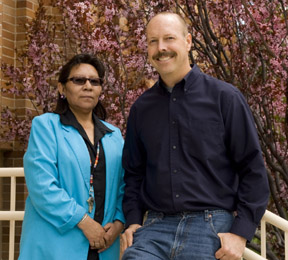Idaho State University Shoshoni Language Project still going strong after 20 years
April 30, 2009
The Idaho State University Shoshoni Language Project, celebrating its 20-year anniversary, is still going strong, helping to preserve the Shoshoni language and expand its usage.
“As the Shoshoni Language classes were developed as a part of the American Indian Studies Program here at Idaho State University, other Shoshoni speaking communities became interested and developed language materials in their own dialects to serve their own communities,” said Drusilla Gould, ISU anthropology department instructor.

Gould, who is a native Shoshoni speaker from the Shoshone-Bannock Tribes and was raised at the Fort Hall Indian Reservation, and ISU anthropology professor Christopher Loether began the project in 1989 and have remained active since. Statistics from the 1990 and 2000 U.S. Censuses appear to verify that the ISU program has helped propagate the use of the language. In 1990 the U.S. Census counted 2,284 Shoshoni speakers, while the 2000 Census reported 2,724, an increase of 440 speakers.
The two ISU faculty members don’t in any way try to take full credit for this increase, but point out that their efforts have helped preserve the language and make it easier to teach.
Initially, Loether and Gould studied the linguistics of the Shoshoni language and started creating the first Shoshoni language dictionary and a Shoshoni language writing system. Their Shoshoni language dictionary produced by the ISU anthropology department, located online at www.shoshonidictionary.com, now consists of 3,000 words and continues to grow as words are added.
Loether and Gould also developed lesson plans to teach both the language and the writing system, which eventually morphed into a textbook, “An Introduction to the Shoshoni Language, Dammen Daigwape.”
The writing system, dictionary and textbook – the whole program created at Idaho State University – were picked up, modified and used by other Shoshoni communities near Ely, Nev., and Wind River, Wyo. Central Wyoming College also adapted the Shoshoni Language Project for its use. Language learning materials developed by the Shoshoni Language Project also are currently being used in primary and secondary schools throughout Shoshoni Country. Thus, not only are more people learning and being taught the language in systematic fashion locally, but the language is being taught in a systematic manner in other Shoshoni communities as well.
“Shoshoni language and culture is the foundation of the lifestyle of the Shoshoni people,” Gould said. “The students learn about the origin of the Shoshoni words in the classroom and leave with a positive perspective about their unique culture and language.”
Shoshoni is a complex language and is not standardized between the 26 different Shoshoni bands and 15 different Shoshoni Indian reservations, made up by approximately 12,000 members. There may be three or four Shoshoni words for one English word, depending on the dialect spoken. Also, Eastern, Western, Northern and Southern Shoshoni might use a different word for the same item. Thus, the program for teaching the language must be flexible and adaptable.
Of course, the program ISU developed isn’t just about the language, but helps preserve the Shoshoni culture. Each textbook language lesson integrates lessons in Shoshoni culture, such as not looking directly at an elder when speaking. The book also talks about where and how words originated and their traditional meanings. The Shoshoni language also has many idiosyncrasies, which are being documented and preserved. For example, a speaker addresses an individual, a pair of people and a group of people differently.
Idaho State University has offered elementary and intermediate Shoshoni language classes, which students can take to fulfill their general education foreign language requirement for the College of Arts and Sciences. ISU also offers advanced Shoshoni grammar classes to students who want to partake in a more in depth study of the language.
On average, the elementary and intermediate classes have been taught to about 35 students a year during the 20-year history of the program. Many of the students have been Shoshoni tribal members, but the classes have also been taken by social workers, health workers, non-Shoshoni tribal members growing up on Fort Hall, and by anthropology students, including those from out of state, interested in the language.
Despite their efforts and the efforts of their colleagues, Loether and Gould said the Shoshoni language is still endangered. The Shoshoni Language Project estimates that approximately 40 percent of Shoshoni tribal members speak their native language, but those over the age of 50 are much more likely than younger Shoshoni to speak it. This underlies the importance of having a system available to teach younger speakers.
“We’re not out of the endangered area yet,” Loether said. “But we are a lot better off than we were 20 years ago. People realized the language was dying out, but something could be done about it.”
“Idaho State University is committed to continuing to teach and preserve the language,” added Loether, “through the strength of the Shoshoni Language Project.”
For more information on the Shoshoni Language Project contact the ISU Department of Anthropology at (208) 282-2629.
Categories:
